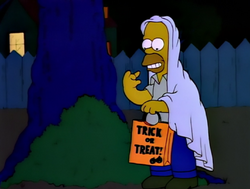|
|
| (10 intermediate revisions by 3 users not shown) |
| Line 1: |
Line 1: |
| | + | [[File:Halloween.png|250px|right]] |
| | '''Halloween''' is a holiday celebrated on October 31st. | | '''Halloween''' is a holiday celebrated on October 31st. |
| − |
| |
| − | == History ==
| |
| − | About 2000 years ago, a group of people called the Celts lived in Ireland, the United Kingdom, and the parts of northern France celebrated a very festive New Year's Eve celebration on the last day of the Celtic year. It marked the end of the summer months the final harvest season and the beginning of the dark cold winter, a time of year that was often associated with human death. Their new year started the next day, but on that night, the Celts believed that the ghosts from the dead along with fairies goblins and other evil creatures came back to roam the Earth because the boundary between the worlds of the living and the dead became very blurred. The Celts had traditional ways to drive the dead back to the spirit world. First they put out the hearth fires in their homes so that the homes looked cold and deserted. Then they attempted to tell each other's fortunes. Then the Druids built huge sacred bonfires, where the people are gathered to burn crops and animals as sacrifices to the Celtic deities. Then they dressed up in spooky costumes that looked like ghosts or other evil creatures. And they danced around the neighborhood making lots of noises. They thought that the evil spirits were mistaken into believing they were ghosts as well but they left their doors open so that the good spirits can join in. When the celebration was over, they re-lit their hearth fires, which they had extinguished earlier that evening, from the sacred bonfire to help protect them during the coming winter. By 43 A.D., the Roman Empire had conquered the majority of Celtic territory. In the course of the four hundred years that they ruled the Celtic lands, two festivals of Roman origin were combined with the traditional Celtic celebration of Samhain. The first was Feralia, a day in late October when the Romans traditionally commemorated the passing of the dead. The second was a day to honor Pomona, the Roman goddess of fruit and the trees. For this is why it became the tradition of bobbing for apples. On May 13, 609 A.D., Pope Boniface IV dedicated the Pantheon in Rome in honor of all Christian martyrs, and the Catholic feast of All Martyrs Day was established in the Western church. Pope Gregory III (731–741) later expanded the festival to include all saints as well as all martyrs, and moved the observance from May 13 through November 1. However that didn't work exactly the way he wanted because the people liked their holidays. By the 9th century the influence of Christianity had spread into Celtic lands, where it gradually blended with and supplanted the older Celtic rites. In 1000 A.D., the church would make November 2 All Souls’ Day, a day to honor the dead. It is widely believed today that the church was attempting to replace the Celtic festival of the dead with a related, but church-sanctioned holiday. All Souls Day was celebrated similarly to Samhain, with big bonfires, parades, and dressing up in costumes as saints, angels and devils. The All Saints Day celebration was also called All-hallows or All-hallowmas Alholowmesse meaning All Saints’ Day and the night before it, the traditional night of Samhain in the Celtic religion, began to be called All-hallows Eve later, the name was changed to Halloween. In the Celtic times up until the middle ages, the Celts began to leave food or drinks outside their door steps as offerings to keep roaming spirits at bay. If they appeased the evil spirits it can expect good luck to happen in the future. But if they didn't leave enough food or drinks for them they will be subjected into unpleasantness. By medieval times, the first popular All Souls' Day practice was to make "soul cakes,". In a custom called "souling," the children would go from door-to-door asking for soul cakes. For every soul cake that a child collected, they promised to say a prayer for the peoples dead relatives who gave them soul cakes. These prayers would help the people's dead relatives find their way out of Purgatory and up into Heaven. In the medieval Halloween custom of "guising", the young people began to dress up in costumes and accepted food, wine, money, and other offerings in exchange for singing, dancing, playing instruments, reciting poetry, or telling jokes. Several centuries ago amongst myriad towns and villages in Ireland, there lived an Irish legend tells the tale of a man named Stingy Jack, invited the Devil to have a drink with him. True to his name, Stingy Jack didn’t want to pay for his drink, so he convinced the Devil to turn himself into a coin that Jack could use to buy their drinks. Once the Devil did so, Jack has decided to keep the money and put it into his pocket next to a silver cross, which stopped the Devil from changing back into his original form. Jack eventually freed the Devil, under one condition that he would not bother Jack for one year and that when Jack should die, he would not claim his soul. The next year, Jack tricked the Devil again into climbing into a tree to pick a piece of fruit. While he was up in the tree, Jack carved a sign of the cross into the tree’s bark so that the Devil could not come down until the Devil promised Jack not to bother him for ten more years. Many years later after his second trick was through, Jack died, and his soul went to go knock on Heaven's door but he was told by Saint Peter that he was mean and rude and because he led a miserable life on Earth, Stingy Jack was not allowed to enter Heaven and Jack decided that he might as well go to Hell instead. When he got to the Gates of Hell and begged for commission into the underworld. He wasn't welcome by the devil, either because of his promise he made to Jack years earlier and because Jack tricked him several times. Now Jack was scared because he had nowhere to go so he pleaded with the Devil to provide him with a light to help him find his way. And as a final gesture, the Devil, tossed Jack an ember straight from the fires of Hell. And from that day to this, Stingy Jack is doomed to roam the Earth between the planes of Heaven and Hell, with only an ember inside a hollowed turnip. Because he couldn't see in the dark, he carved out a turnip or a potato and putted in a lump of coal he got from the devil earlier. The Irish began to refer to this ghostly figure as “Jack of the Lantern,” and then, simply “Jack O’Lantern.” On All-hallows Eve, the Irish people began to hollow out the insides of turnips, gourds, potatoes, and beets, then they carved scary faces outside, and they placed a light in them to protect themselves from the evil spirits and to frighten Jack away from their homes which later became the tradition of carving Jack O’Lanterns”. When the people from Ireland immigrated to America during the potato famine they brought their traditions with them and became today's secular holiday that everyone can enjoy regardless to their religious beliefs.
| |
| | | | |
| | == Appearances == | | == Appearances == |
| Line 11: |
Line 9: |
| | *{{THOH|Treehouse of Horror IV}} | | *{{THOH|Treehouse of Horror IV}} |
| | *{{THOH|Treehouse of Horror V}} | | *{{THOH|Treehouse of Horror V}} |
| | + | *{{ep|Homer vs. Patty and Selma}} |
| | *{{THOH|Treehouse of Horror VI}} | | *{{THOH|Treehouse of Horror VI}} |
| | *{{THOH|Treehouse of Horror VII}} | | *{{THOH|Treehouse of Horror VII}} |
| Line 23: |
Line 22: |
| | *{{THOH|Treehouse of Horror XVI}} | | *{{THOH|Treehouse of Horror XVI}} |
| | *{{THOH|Treehouse of Horror XVII}} | | *{{THOH|Treehouse of Horror XVII}} |
| | + | *{{ep|Marge Gamer|(mentioned)}} |
| | *{{THOH|Treehouse of Horror XVIII}} | | *{{THOH|Treehouse of Horror XVIII}} |
| | *{{THOH|Treehouse of Horror XIX}} | | *{{THOH|Treehouse of Horror XIX}} |
| Line 31: |
Line 31: |
| | *{{THOH|Treehouse of Horror XXIV}} | | *{{THOH|Treehouse of Horror XXIV}} |
| | *{{THOH|Treehouse of Horror XXV}} | | *{{THOH|Treehouse of Horror XXV}} |
| | + | *{{ep|Halloween of Horror}} |
| | *{{THOH|Treehouse of Horror XXVI}} | | *{{THOH|Treehouse of Horror XXVI}} |
| | *{{THOH|Treehouse of Horror XXVII}} | | *{{THOH|Treehouse of Horror XXVII}} |
| − | *{{ep|Halloween of Horror}} | + | *{{ep|Springfield Splendor|(mentioned)}} |
| | + | *{{THOH|Treehouse of Horror XXVIII}} |
| | + | *{{THOH|Treehouse of Horror XXIX}} |
| | + | *{{ep|Baby You Can't Drive My Car|(mentioned)}} |
| | + | *{{ep|The Clown Stays in the Picture|(mentioned)}} |
| | + | *{{THOH|Treehouse of Horror XXX}} |
| | + | *{{THOH|Treehouse of Horror XXXI}} |
| | + | *{{THOH|Treehouse of Horror XXXII}} |
| | + | *{{ep|Lisa the Boy Scout|(mentioned)}} |
| | + | *{{THOH|Treehouse of Horror XXXIII}} |
| | + | *{{THOH|Treehouse of Horror XXXIV}} |
| | + | *{{bon|Sideshow Blob!}} |
| | + | *{{bon|Anchor Blues|(mentioned)}} |
| | + | *{{bon|The Winter of Our Discount Tent}} |
| | + | *{{bon|Comic Book Guy's Best Costumes Ever - Part 1|(mentioned)}} |
| | + | *{{bon|Comic Book Guy's Best Costumes Ever - Part 2|(mentioned)}} |
| | + | *{{bon|Comic Book Guy's Best Costumes Ever - Part 4|(mentioned)}} |
| | *{{game|The Simpsons: Tapped Out}} | | *{{game|The Simpsons: Tapped Out}} |
| | }} | | }} |


